engine INFINITI QX56 2007 Factory Workshop Manual
[x] Cancel search | Manufacturer: INFINITI, Model Year: 2007, Model line: QX56, Model: INFINITI QX56 2007Pages: 3061, PDF Size: 64.56 MB
Page 115 of 3061

TROUBLE DIAGNOSIS
AT-45
< SERVICE INFORMATION >
D
E
F
G
H
I
J
K
L
MA
B
AT
N
O
P
It is much more difficult to diagnose a error that occurs intermittently
rather than continuously. Most intermittent errors are caused by poor
electric connections or improper wiring. In this case, careful check-
ing of suspected circuits may help prevent the replacement of good
parts.
A visual check only may not find the cause of the errors. A road test
with CONSULT-II (or GST) or a circuit tester connected should be
performed. Follow the "WORK FLOW".
Before undertaking actual checks, take a few minutes to talk with a
customer who approaches with a driveability complaint. The cus-
tomer can supply good information about such errors, especially
intermittent ones. Find out what symptoms are present and under
what conditions they occur. A “Diagnostic Worksheet” as shown on
the example (Refer to "Diagnostic Worksheet Chart") should be
used.
Start your diagnosis by looking for “conventional” errors first. This will
help troubleshoot driveability errors on an electronically controlled
engine vehicle.
Also check related Service bulletins.
WORK FLOW
A good understanding of the malfunction conditions can make troubleshooting faster and more accurate.
In general, each customer feels differently about a malfunction. It is important to fully understand the symp-
toms or conditions for a customer complaint.
Make good use of the two sheets provided, “Information From Customer” (Refer to "Information From Cus-
tomer") and “Diagnostic Worksheet” (Refer to "Diagnostic Worksheet Chart"), to perform the best trouble-
shooting possible.
Work Flow Chart
SAT632I
SEF234G
Page 117 of 3061

TROUBLE DIAGNOSIS
AT-47
< SERVICE INFORMATION >
D
E
F
G
H
I
J
K
L
MA
B
AT
N
O
P Diagnostic Worksheet Chart
Customer name MR/MS Model & Year VIN
Trans. Model Engine Mileage
Malfunction Date Manuf. Date In Service Date
Frequencyo Continuouso Intermittent ( times a day)
Symptomso Vehicle does not move. (o Any positiono Particular position)
o No up-shift (o 1st → 2ndo 2nd → 3rdo 3rd → 4th o 4th → 5th)
o No down-shift (o 5th → 4th o 4th → 3rdo 3rd → 2ndo 2nd → 1st)
o Lock-up malfunction
o Shift point too high or too low.
o Shift shock or slip (o N → Do Lock-upo Any drive position)
o Noise or vibration
o No kick down
o No pattern select
o Others
()
Malfunction indicator lamp (MIL)o Continuously lito Not lit
1o Read the item on cautions concerning fail-safe and understand the customer's complaint.AT- 4 3
2o ATF inspection
AT- 5 1o Leak (Repair leak location.)
o Sta te
o Amount
3o Stall test and line pressure test
AT- 5 1
, AT-
51
o Stall test
o Torque converter one-way clutch
o Front brake
o High and low reverse clutch
o Low coast brake
o Forward brake
o Reverse brake
o Forward one-way clutcho 1st one-way clutch
o 3rd one-way clutch
o Engine
o Line pressure low
o Except for input clutch and direct
clutch, clutches and brakes OK
o Line pressure inspection - Suspected part:
Page 118 of 3061
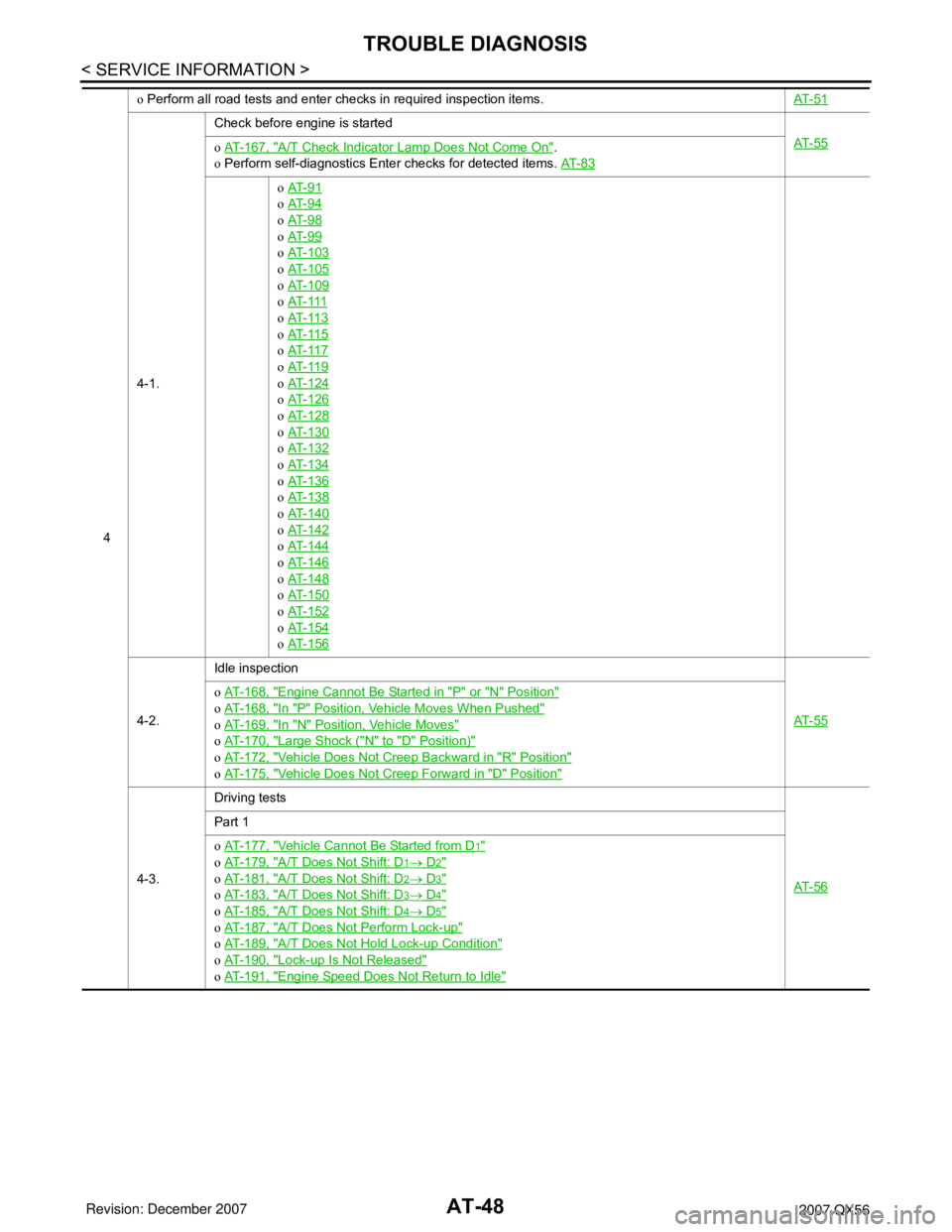
AT-48
< SERVICE INFORMATION >
TROUBLE DIAGNOSIS
4o Perform all road tests and enter checks in required inspection items.AT- 5 1
4-1.Check before engine is started
AT- 5 5
o AT- 1 6 7 , "A/T Check Indicator Lamp Does Not Come On".
o Perform self-diagnostics Enter checks for detected items. AT- 8 3
o AT- 9 1
o AT- 9 4
o AT- 9 8
o AT- 9 9
o AT- 1 0 3
o AT- 1 0 5
o AT- 1 0 9
o AT- 111
o AT- 11 3
o AT- 11 5
o AT- 11 7
o AT- 11 9
o AT- 1 2 4
o AT- 1 2 6
o AT- 1 2 8
o AT- 1 3 0
o AT- 1 3 2
o AT- 1 3 4
o AT- 1 3 6
o AT- 1 3 8
o AT- 1 4 0
o AT- 1 4 2
o AT- 1 4 4
o AT- 1 4 6
o AT- 1 4 8
o AT- 1 5 0
o AT- 1 5 2
o AT- 1 5 4
o AT- 1 5 6
4-2.Idle inspection
AT- 5 5
o AT- 1 6 8 , "Engine Cannot Be Started in "P" or "N" Position"
o AT- 1 6 8 , "In "P" Position, Vehicle Moves When Pushed"
o AT- 1 6 9 , "In "N" Position, Vehicle Moves"
o AT- 1 7 0 , "Large Shock ("N" to "D" Position)"
o AT- 1 7 2 , "Vehicle Does Not Creep Backward in "R" Position"
o AT- 1 7 5 , "Vehicle Does Not Creep Forward in "D" Position"
4-3.Driving tests
AT- 5 6
Part 1
o AT- 1 7 7 , "
Vehicle Cannot Be Started from D1"
o AT- 1 7 9 , "A/T Does Not Shift: D1→ D2"
o AT- 1 8 1 , "A/T Does Not Shift: D2→ D3"
o AT- 1 8 3 , "A/T Does Not Shift: D3→ D4"
o AT- 1 8 5 , "A/T Does Not Shift: D4→ D5"
o AT- 1 8 7 , "A/T Does Not Perform Lock-up"
o AT- 1 8 9 , "A/T Does Not Hold Lock-up Condition"
o AT- 1 9 0 , "Lock-up Is Not Released"
o AT- 1 9 1 , "Engine Speed Does Not Return to Idle"
Page 119 of 3061
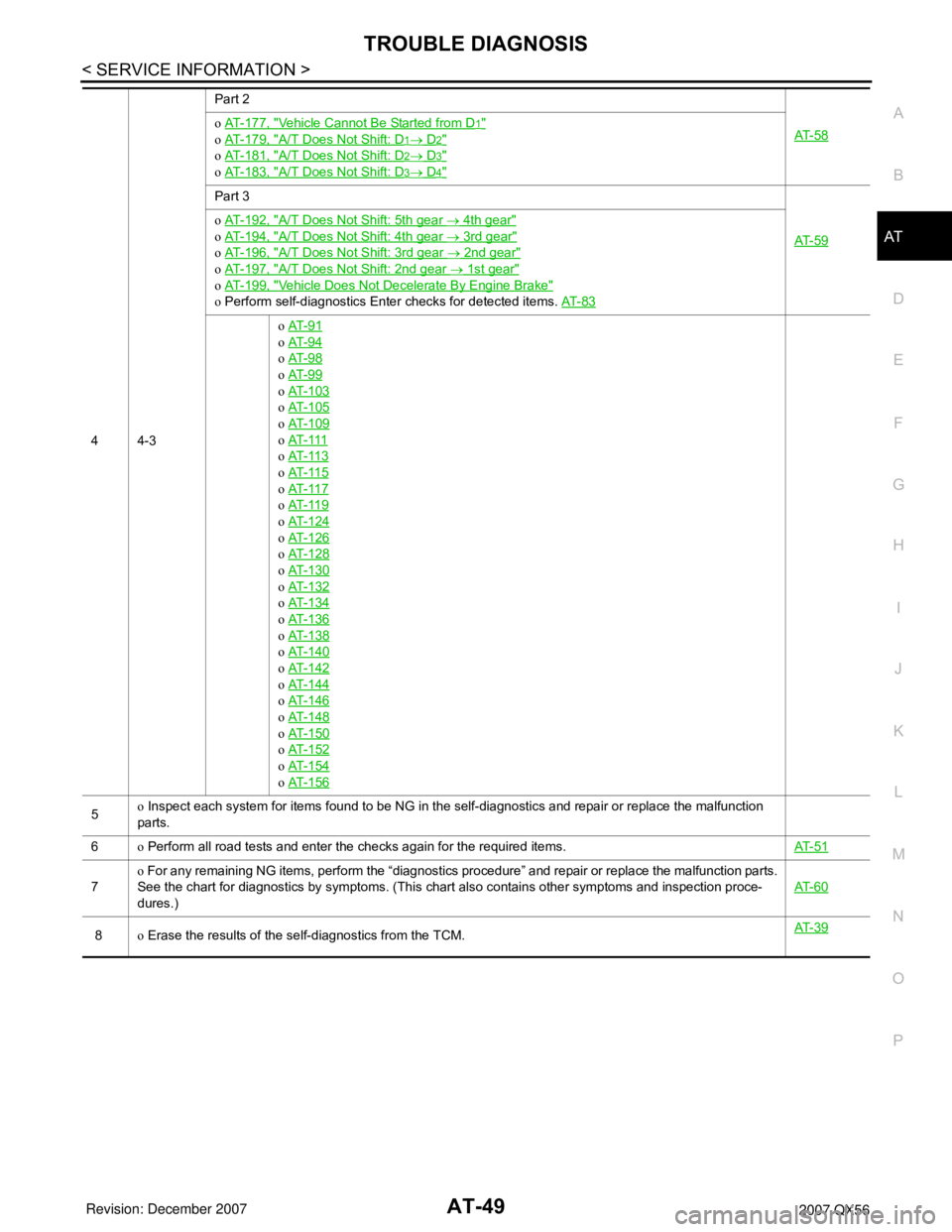
TROUBLE DIAGNOSIS
AT-49
< SERVICE INFORMATION >
D
E
F
G
H
I
J
K
L
MA
B
AT
N
O
P
44-3Part 2
AT- 5 8
o AT- 1 7 7 , "Vehicle Cannot Be Started from D1"
o AT- 1 7 9 , "A/T Does Not Shift: D1→ D2"
o AT- 1 8 1 , "A/T Does Not Shift: D2→ D3"
o AT- 1 8 3 , "A/T Does Not Shift: D3→ D4"
Part 3
AT- 5 9
o AT- 1 9 2 , "A/T Does Not Shift: 5th gear → 4th gear"
o AT- 1 9 4 , "A/T Does Not Shift: 4th gear → 3rd gear"
o AT- 1 9 6 , "A/T Does Not Shift: 3rd gear → 2nd gear"
o AT- 1 9 7 , "A/T Does Not Shift: 2nd gear → 1st gear"
o AT- 1 9 9 , "Vehicle Does Not Decelerate By Engine Brake"
o Perform self-diagnostics Enter checks for detected items. AT- 8 3
o AT- 9 1
o AT- 9 4
o AT- 9 8
o AT- 9 9
o AT- 1 0 3
o AT- 1 0 5
o AT- 1 0 9
o AT- 111
o AT- 11 3
o AT- 11 5
o AT- 11 7
o AT- 11 9
o AT- 1 2 4
o AT- 1 2 6
o AT- 1 2 8
o AT- 1 3 0
o AT- 1 3 2
o AT- 1 3 4
o AT- 1 3 6
o AT- 1 3 8
o AT- 1 4 0
o AT- 1 4 2
o AT- 1 4 4
o AT- 1 4 6
o AT- 1 4 8
o AT- 1 5 0
o AT- 1 5 2
o AT- 1 5 4
o AT- 1 5 6
5o Inspect each system for items found to be NG in the self-diagnostics and repair or replace the malfunction
parts.
6o Perform all road tests and enter the checks again for the required items.AT- 5 1
7o For any remaining NG items, perform the “diagnostics procedure” and repair or replace the malfunction parts.
See the chart for diagnostics by symptoms. (This chart also contains other symptoms and inspection proce-
dures.)AT- 6 0
8o Erase the results of the self-diagnostics from the TCM.AT- 3 9
Page 122 of 3061
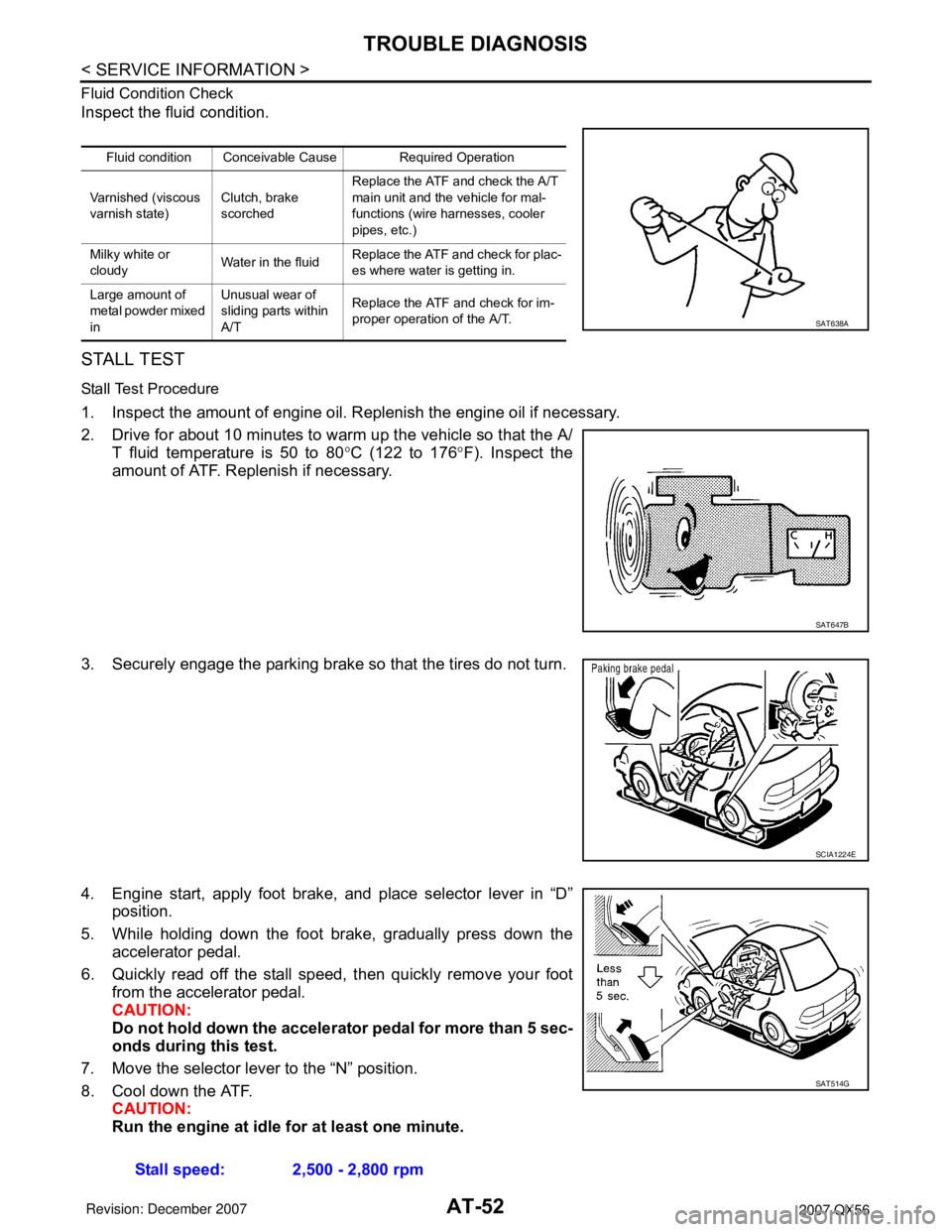
AT-52
< SERVICE INFORMATION >
TROUBLE DIAGNOSIS
Fluid Condition Check
Inspect the fluid condition.
STALL TEST
Stall Test Procedure
1. Inspect the amount of engine oil. Replenish the engine oil if necessary.
2. Drive for about 10 minutes to warm up the vehicle so that the A/
T fluid temperature is 50 to 80°C (122 to 176°F). Inspect the
amount of ATF. Replenish if necessary.
3. Securely engage the parking brake so that the tires do not turn.
4. Engine start, apply foot brake, and place selector lever in “D”
position.
5. While holding down the foot brake, gradually press down the
accelerator pedal.
6. Quickly read off the stall speed, then quickly remove your foot
from the accelerator pedal.
CAUTION:
Do not hold down the accelerator pedal for more than 5 sec-
onds during this test.
7. Move the selector lever to the “N” position.
8. Cool down the ATF.
CAUTION:
Run the engine at idle for at least one minute.
Fluid condition Conceivable Cause Required Operation
Varnished (viscous
varnish state)Clutch, brake
scorchedReplace the ATF and check the A/T
main unit and the vehicle for mal-
functions (wire harnesses, cooler
pipes, etc.)
Milky white or
cloudyWater in the fluidReplace the ATF and check for plac-
es where water is getting in.
Large amount of
metal powder mixed
inUnusual wear of
sliding parts within
A/TReplace the ATF and check for im-
proper operation of the A/T.
SAT638A
SAT647B
SCIA1224E
Stall speed: 2,500 - 2,800 rpm
SAT514G
Page 123 of 3061
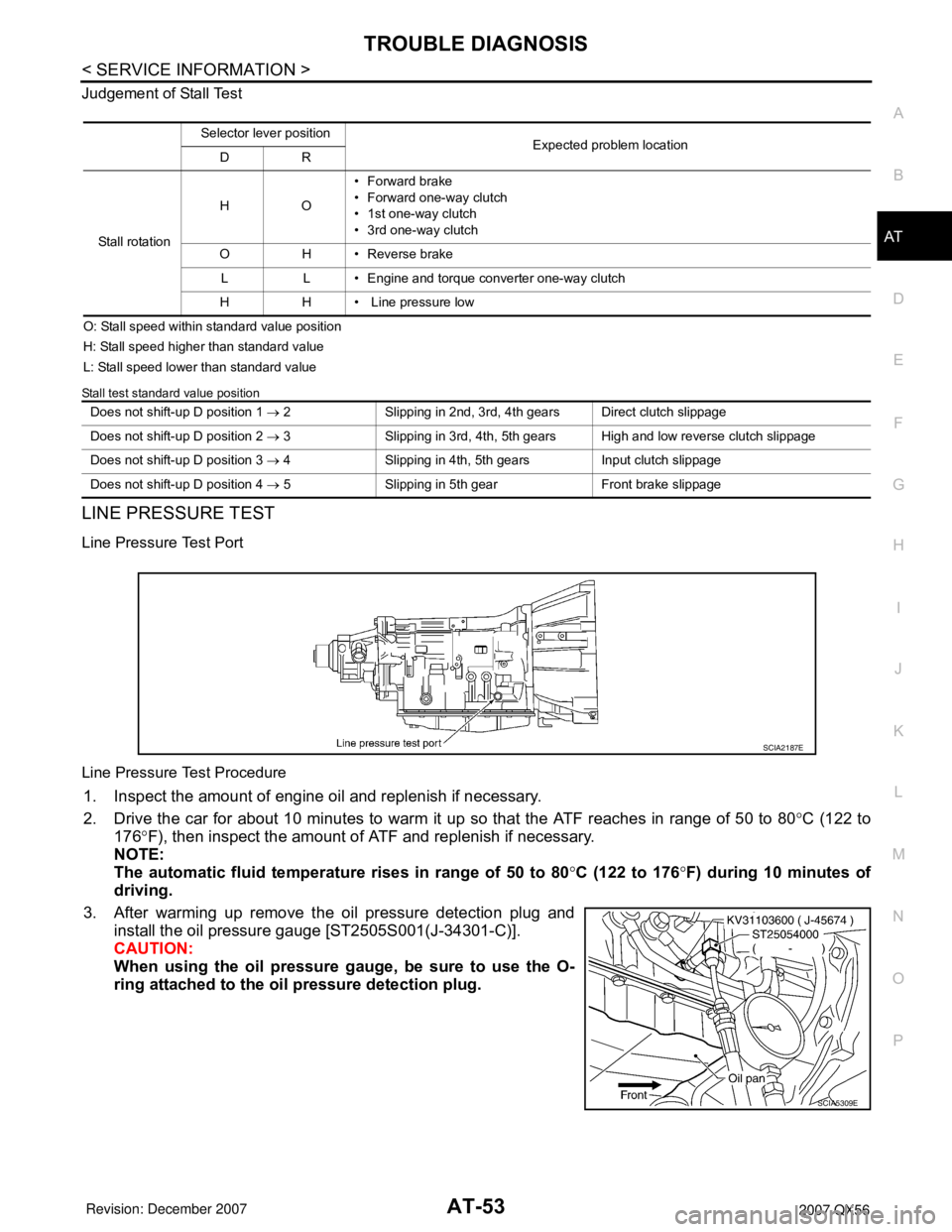
TROUBLE DIAGNOSIS
AT-53
< SERVICE INFORMATION >
D
E
F
G
H
I
J
K
L
MA
B
AT
N
O
P Judgement of Stall Test
O: Stall speed within standard value position
H: Stall speed higher than standard value
L: Stall speed lower than standard value
Stall test standard value position
LINE PRESSURE TEST
Line Pressure Test Port
Line Pressure Test Procedure
1. Inspect the amount of engine oil and replenish if necessary.
2. Drive the car for about 10 minutes to warm it up so that the ATF reaches in range of 50 to 80°C (122 to
176°F), then inspect the amount of ATF and replenish if necessary.
NOTE:
The automatic fluid temperature rises in range of 50 to 80°C (122 to 176°F) during 10 minutes of
driving.
3. After warming up remove the oil pressure detection plug and
install the oil pressure gauge [ST2505S001(J-34301-C)].
CAUTION:
When using the oil pressure gauge, be sure to use the O-
ring attached to the oil pressure detection plug.
Selector lever position
Expected problem location
DR
Stall rotation HO• Forward brake
• Forward one-way clutch
• 1st one-way clutch
• 3rd one-way clutch
O H • Reverse brake
L L • Engine and torque converter one-way clutch
H H • Line pressure low
Does not shift-up D position 1 → 2 Slipping in 2nd, 3rd, 4th gears Direct clutch slippage
Does not shift-up D position 2 → 3 Slipping in 3rd, 4th, 5th gears High and low reverse clutch slippage
Does not shift-up D position 3 → 4 Slipping in 4th, 5th gears Input clutch slippage
Does not shift-up D position 4 → 5 Slipping in 5th gear Front brake slippage
SCIA2187E
SCIA5309E
Page 124 of 3061
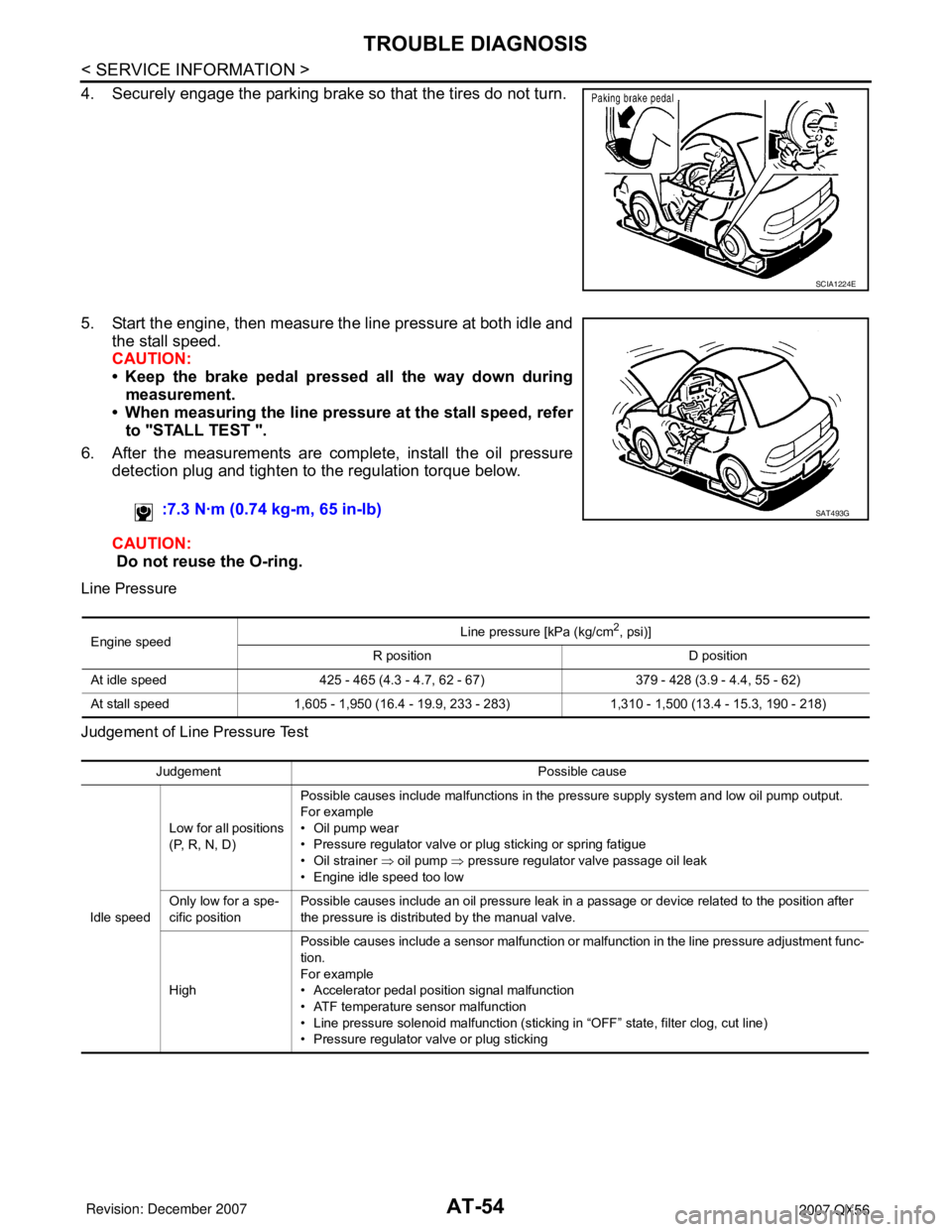
AT-54
< SERVICE INFORMATION >
TROUBLE DIAGNOSIS
4. Securely engage the parking brake so that the tires do not turn.
5. Start the engine, then measure the line pressure at both idle and
the stall speed.
CAUTION:
• Keep the brake pedal pressed all the way down during
measurement.
• When measuring the line pressure at the stall speed, refer
to "STALL TEST ".
6. After the measurements are complete, install the oil pressure
detection plug and tighten to the regulation torque below.
CAUTION:
Do not reuse the O-ring.
Line Pressure
Judgement of Line Pressure Test
SCIA1224E
:7.3 N·m (0.74 kg-m, 65 in-lb)SAT493G
Engine speedLine pressure [kPa (kg/cm
2, psi)]
R position D position
At idle speed 425 - 465 (4.3 - 4.7, 62 - 67) 379 - 428 (3.9 - 4.4, 55 - 62)
At stall speed 1,605 - 1,950 (16.4 - 19.9, 233 - 283) 1,310 - 1,500 (13.4 - 15.3, 190 - 218)
Judgement Possible cause
Idle speedLow for all positions
(P, R, N, D)Possible causes include malfunctions in the pressure supply system and low oil pump output.
For example
•Oil pump wear
• Pressure regulator valve or plug sticking or spring fatigue
• Oil strainer ⇒ oil pump ⇒ pressure regulator valve passage oil leak
• Engine idle speed too low
Only low for a spe-
cific positionPossible causes include an oil pressure leak in a passage or device related to the position after
the pressure is distributed by the manual valve.
HighPossible causes include a sensor malfunction or malfunction in the line pressure adjustment func-
tion.
For example
• Accelerator pedal position signal malfunction
• ATF temperature sensor malfunction
• Line pressure solenoid malfunction (sticking in “OFF” state, filter clog, cut line)
• Pressure regulator valve or plug sticking
Page 125 of 3061
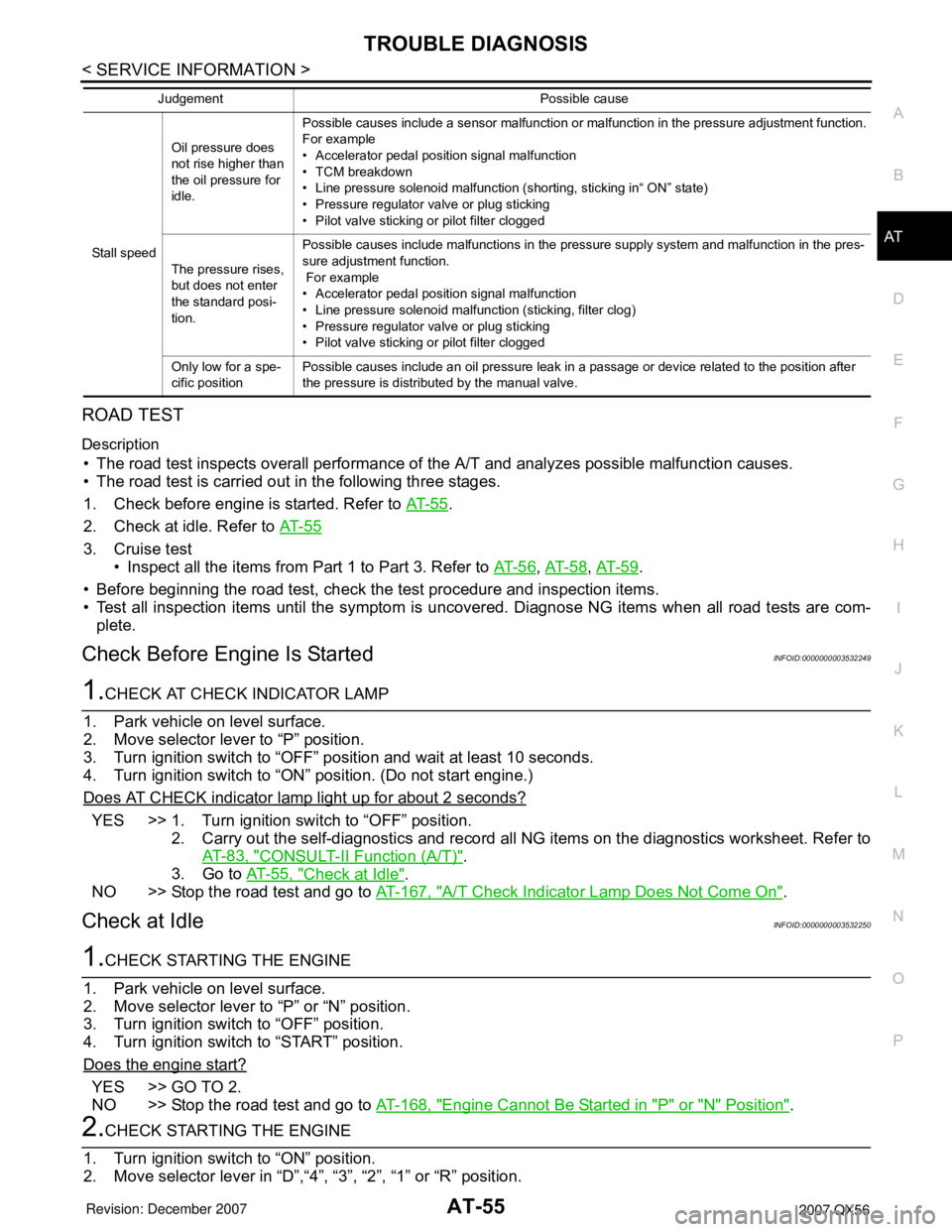
TROUBLE DIAGNOSIS
AT-55
< SERVICE INFORMATION >
D
E
F
G
H
I
J
K
L
MA
B
AT
N
O
P
ROAD TEST
Description
• The road test inspects overall performance of the A/T and analyzes possible malfunction causes.
• The road test is carried out in the following three stages.
1. Check before engine is started. Refer to AT- 5 5
.
2. Check at idle. Refer to AT- 5 5
3. Cruise test
• Inspect all the items from Part 1 to Part 3. Refer to AT- 5 6
, AT- 5 8, AT- 5 9.
• Before beginning the road test, check the test procedure and inspection items.
• Test all inspection items until the symptom is uncovered. Diagnose NG items when all road tests are com-
plete.
Check Before Engine Is StartedINFOID:0000000003532249
1.CHECK AT CHECK INDICATOR LAMP
1. Park vehicle on level surface.
2. Move selector lever to “P” position.
3. Turn ignition switch to “OFF” position and wait at least 10 seconds.
4. Turn ignition switch to “ON” position. (Do not start engine.)
Does AT CHECK indicator lamp light up for about 2 seconds?
YES >> 1. Turn ignition switch to “OFF” position.
2. Carry out the self-diagnostics and record all NG items on the diagnostics worksheet. Refer to
AT-83, "
CONSULT-II Function (A/T)".
3. Go to AT-55, "
Check at Idle".
NO >> Stop the road test and go to AT-167, "
A/T Check Indicator Lamp Does Not Come On".
Check at IdleINFOID:0000000003532250
1.CHECK STARTING THE ENGINE
1. Park vehicle on level surface.
2. Move selector lever to “P” or “N” position.
3. Turn ignition switch to “OFF” position.
4. Turn ignition switch to “START” position.
Does the engine start?
YES >> GO TO 2.
NO >> Stop the road test and go to AT-168, "
Engine Cannot Be Started in "P" or "N" Position".
2.CHECK STARTING THE ENGINE
1. Turn ignition switch to “ON” position.
2. Move selector lever in “D”,“4”, “3”, “2”, “1” or “R” position.
Stall speedOil pressure does
not rise higher than
the oil pressure for
idle.Possible causes include a sensor malfunction or malfunction in the pressure adjustment function.
For example
• Accelerator pedal position signal malfunction
• TCM breakdown
• Line pressure solenoid malfunction (shorting, sticking in“ ON” state)
• Pressure regulator valve or plug sticking
• Pilot valve sticking or pilot filter clogged
The pressure rises,
but does not enter
the standard posi-
tion.Possible causes include malfunctions in the pressure supply system and malfunction in the pres-
sure adjustment function.
For example
• Accelerator pedal position signal malfunction
• Line pressure solenoid malfunction (sticking, filter clog)
• Pressure regulator valve or plug sticking
• Pilot valve sticking or pilot filter clogged
Only low for a spe-
cific positionPossible causes include an oil pressure leak in a passage or device related to the position after
the pressure is distributed by the manual valve. Judgement Possible cause
Page 126 of 3061
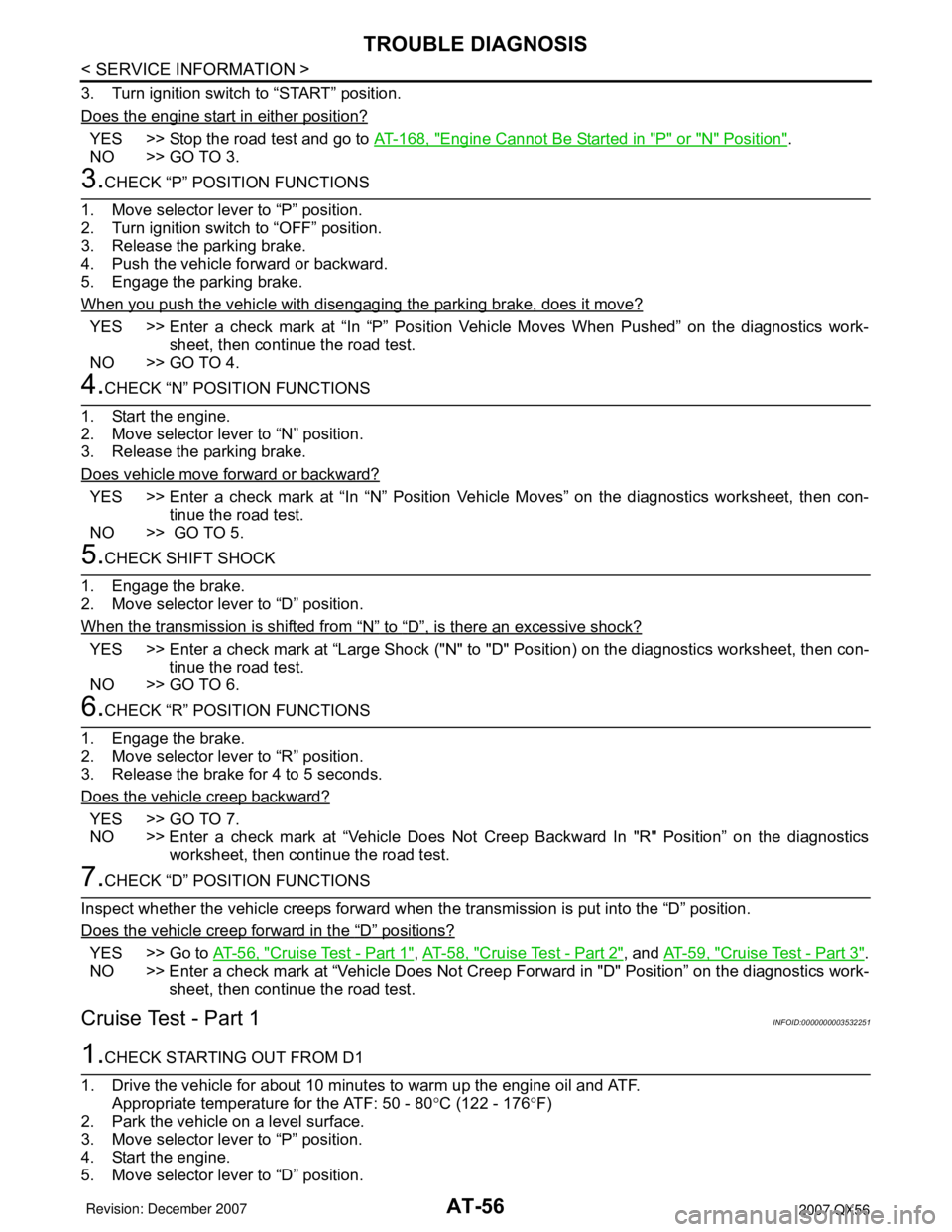
AT-56
< SERVICE INFORMATION >
TROUBLE DIAGNOSIS
3. Turn ignition switch to “START” position.
Does the engine start in either position?
YES >> Stop the road test and go to AT-168, "Engine Cannot Be Started in "P" or "N" Position".
NO >> GO TO 3.
3.CHECK “P” POSITION FUNCTIONS
1. Move selector lever to “P” position.
2. Turn ignition switch to “OFF” position.
3. Release the parking brake.
4. Push the vehicle forward or backward.
5. Engage the parking brake.
When you push the vehicle with disengaging the parking brake, does it move?
YES >> Enter a check mark at “In “P” Position Vehicle Moves When Pushed” on the diagnostics work-
sheet, then continue the road test.
NO >> GO TO 4.
4.CHECK “N” POSITION FUNCTIONS
1. Start the engine.
2. Move selector lever to “N” position.
3. Release the parking brake.
Does vehicle move forward or backward?
YES >> Enter a check mark at “In “N” Position Vehicle Moves” on the diagnostics worksheet, then con-
tinue the road test.
NO >> GO TO 5.
5.CHECK SHIFT SHOCK
1. Engage the brake.
2. Move selector lever to “D” position.
When the transmission is shifted from
“N” to “D”, is there an excessive shock?
YES >> Enter a check mark at “Large Shock ("N" to "D" Position) on the diagnostics worksheet, then con-
tinue the road test.
NO >> GO TO 6.
6.CHECK “R” POSITION FUNCTIONS
1. Engage the brake.
2. Move selector lever to “R” position.
3. Release the brake for 4 to 5 seconds.
Does the vehicle creep backward?
YES >> GO TO 7.
NO >> Enter a check mark at “Vehicle Does Not Creep Backward In "R" Position” on the diagnostics
worksheet, then continue the road test.
7.CHECK “D” POSITION FUNCTIONS
Inspect whether the vehicle creeps forward when the transmission is put into the “D” position.
Does the vehicle creep forward in the
“D” positions?
YES >> Go to AT-56, "Cruise Test - Part 1", AT-58, "Cruise Test - Part 2", and AT-59, "Cruise Test - Part 3".
NO >> Enter a check mark at “Vehicle Does Not Creep Forward in "D" Position” on the diagnostics work-
sheet, then continue the road test.
Cruise Test - Part 1INFOID:0000000003532251
1.CHECK STARTING OUT FROM D1
1. Drive the vehicle for about 10 minutes to warm up the engine oil and ATF.
Appropriate temperature for the ATF: 50 - 80°C (122 - 176°F)
2. Park the vehicle on a level surface.
3. Move selector lever to “P” position.
4. Start the engine.
5. Move selector lever to “D” position.
Page 128 of 3061
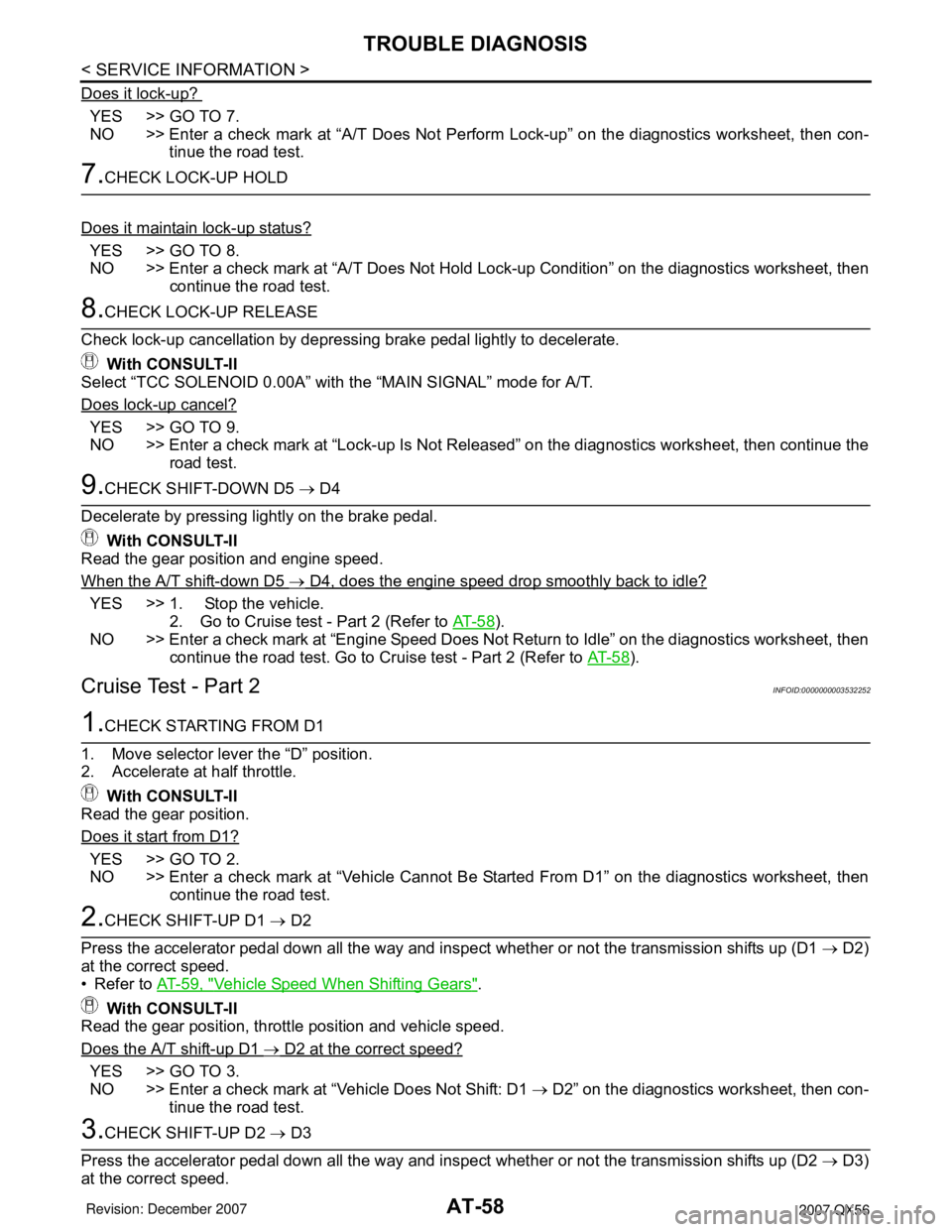
AT-58
< SERVICE INFORMATION >
TROUBLE DIAGNOSIS
Does it lock-up?
YES >> GO TO 7.
NO >> Enter a check mark at “A/T Does Not Perform Lock-up” on the diagnostics worksheet, then con-
tinue the road test.
7.CHECK LOCK-UP HOLD
Does it maintain lock-up status?
YES >> GO TO 8.
NO >> Enter a check mark at “A/T Does Not Hold Lock-up Condition” on the diagnostics worksheet, then
continue the road test.
8.CHECK LOCK-UP RELEASE
Check lock-up cancellation by depressing brake pedal lightly to decelerate.
With CONSULT-II
Select “TCC SOLENOID 0.00A” with the “MAIN SIGNAL” mode for A/T.
Does lock-up cancel?
YES >> GO TO 9.
NO >> Enter a check mark at “Lock-up Is Not Released” on the diagnostics worksheet, then continue the
road test.
9.CHECK SHIFT-DOWN D5 → D4
Decelerate by pressing lightly on the brake pedal.
With CONSULT-II
Read the gear position and engine speed.
When the A/T shift-down D5
→ D4, does the engine speed drop smoothly back to idle?
YES >> 1. Stop the vehicle.
2. Go to Cruise test - Part 2 (Refer to AT- 5 8
).
NO >> Enter a check mark at “Engine Speed Does Not Return to Idle” on the diagnostics worksheet, then
continue the road test. Go to Cruise test - Part 2 (Refer to AT- 5 8
).
Cruise Test - Part 2INFOID:0000000003532252
1.CHECK STARTING FROM D1
1. Move selector lever the “D” position.
2. Accelerate at half throttle.
With CONSULT-II
Read the gear position.
Does it start from D1?
YES >> GO TO 2.
NO >> Enter a check mark at “Vehicle Cannot Be Started From D1” on the diagnostics worksheet, then
continue the road test.
2.CHECK SHIFT-UP D1 → D2
Press the accelerator pedal down all the way and inspect whether or not the transmission shifts up (D1 → D2)
at the correct speed.
• Refer to AT-59, "
Vehicle Speed When Shifting Gears".
With CONSULT-II
Read the gear position, throttle position and vehicle speed.
Does the A/T shift-up D1
→ D2 at the correct speed?
YES >> GO TO 3.
NO >> Enter a check mark at “Vehicle Does Not Shift: D1 → D2” on the diagnostics worksheet, then con-
tinue the road test.
3.CHECK SHIFT-UP D2 → D3
Press the accelerator pedal down all the way and inspect whether or not the transmission shifts up (D2 → D3)
at the correct speed.